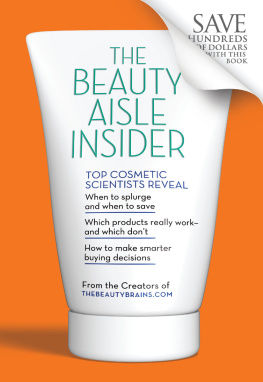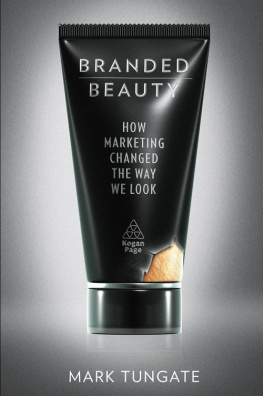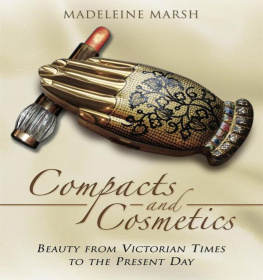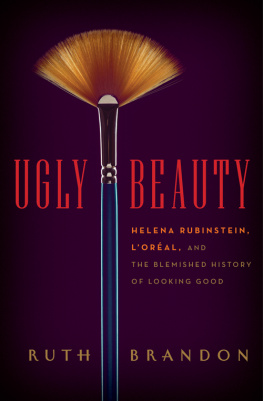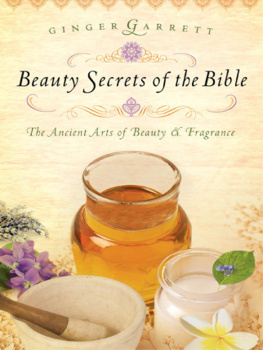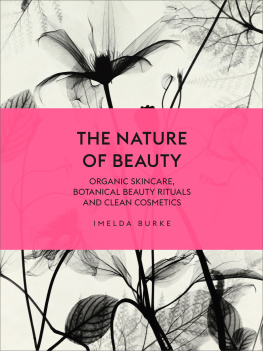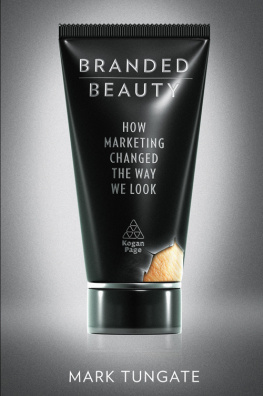Contents
Guide
Martha Laham is a professor at Diablo Valley College, where she has taught business, marketing, and advertising for thirty years. She has authored college textbooks in marketing and selling, developed instructional materials for educational publishers, and contributed to HuffPost. She is the author of The Con Game: A Failure of Trust (2014). Martha lives in Oakland, California.
I would like to express my genuine appreciation to several people without whose support and encouragement this book would not have been possible.
I owe a special debt of gratitude to my extraordinary copyeditor, Elissa Rabellino, for her incisive editorial skills and her invaluable assistance in preparing the manuscript. I am equally grateful to my attorney, Scott Dallas, for his helpful guidance on the legal and regulatory landscape of the cosmetics industry. I also wish to thank Lorna Garano and Peter Handel for their unfailing reassurance and their invaluable feedback on the books concept.
I am much obliged to three generations of marketing and advertising students who joined me in spirited discussions and debates on gender representation in advertising. This book is in large part a response to their abiding interest in this topic.
I would also like to thank my colleagues in the Business Administration Department, the dean of the business division, the vice president of instruction, and the president of Diablo Valley College, for their validation of my research interests.
Thanks to everyone on the Rowman & Littlefield team who gave expert guidance, technical help, and editorial support. My special thanks go out to executive editor Suzanne Staszak-Silva and editorial assistant Charlotte Gosnell. I also wish to acknowledge Rowman & Littlefields highly professional production staff, including senior production editor Alden Perkins, copyeditor Jocquan Mooney, designer Jen Huppert, typesetter Jason Rock, and proofreader Beth Easter.
And last but hardly least, I am most grateful to my family and friends for their unwavering love, optimism, and enthusiasm. Thank you for always believing in me and urging me to press on.
Never underestimate any womans desire for beauty.
Este Lauder (19082004), cofounder, the Este Lauder Companies Inc.
You may be familiar with the pioneers who shaped the modern beauty industry, such as Elizabeth Arden, Helena Rubinstein, Madam C. J. Walker, Max Factor, Charles Revson, Mary Kay Ash, and Este Lauder. These grandes dames and grands seigneurs built billion-dollar empires on the sale of paints and potions primarily designed to satisfy aesthetic needs.
Consider Este Lauder, cofounder of the Este Lauder Companies Inc. Lauder was a natural-born entrepreneur and a visionary marketer. Her groundbreaking promotional tools, including innovative sampling programs and a high-touch approach to cultivating an emotional connection with beauty consumers, have become standard industry practices.
The cosmetics doyenne who changed the face of the beauty industry came from modest roots. Este Lauder, ne Josephine Esther Mentzer, was born and grew up in Queens, New York. She was the ninth child of Jewish immigrants; her mother was Hungarian, and her father was Czech.
Working in her fathers hardware store gave Lauder her first exposure to retail merchandising at an early age. Her uncle, a chemist who created recipes for beauty creams, introduced her to the world of beauty. He took her under his wing and taught her how to combine ingredients to formulate skin creams straight out of the kitchen. During her teen years, she learned the significance of personal selling to create interest in a product and make a sale. Lauder sold her uncles products to her high school classmates by giving them full makeovers.
While making continuous improvements to her uncles formulas, Lauder created a market niche for the final product. Instinctively, she grasped the importance of focusing on the sensory attributes of cosmetic products. She often said, To sell a cream, you sold a dream in the early days.
Lauder was tireless in her pursuit of making a name for herself and her products, using direct sales to accomplish both. Employing an early form of one-toone marketing, she gave free product demonstrations and makeovers at salons, in hotels, in the subway, on the street, and in private homes. Along the way, she cemented her reputation as a cosmetics purveyor and became a staple of New Yorks high society.
In 1946, Lauder and her husband, Joseph, launched the Este Lauder brand with just four skin care products. The Lauders were determined to build a market for premium beauty products by targeting middle-class and wealthy women who had the means and motivation to purchase premium brands that were imbued with an aura of elegance and sophistication. To accomplish this business objective, Lauder made a crucial distribution decision. Instead of selling the companys products through mass-market retailers, such as drugstores, supermarkets, and variety stores, or making them available at company-owned salons, like Elizabeth Arden and Helena Rubin-stein, Lauder set her sights on carriage-trade retailers.
Lauder approached many department store buyers to persuade them to carry Este Lauder products. She finally landed her first department store account with Saks Fifth Avenue. The New Yorkbased luxury department store placed an order for $800 worth of products, which sold out within two days. Lauder personally attended to every aspect of merchandising, from designing cosmetic display counters to supervising sales representatives and working behind the counter to interacting with customers. And it was around this time that Lauder launched a novel consumer promotion, a gift-with-purchase premium.
By the late 1950s, the Este Lauder brand had become one of the most recognized beauty brands among department store shoppers. Other luxury department stores picked up the Este Lauder collection, including Neiman Marcus, I. Magnin, and Marshall Fields. Then in 1953, Lauder launched her first fragrance, Youth Dew, which marked a turning point in the companys history. Youth Dew was a massive hit within a few years, accounting for 80 percent of company sales. The fledging startup took off and flourished into a multimillion-dollar juggernaut.
During the 1960s and 1970s, the company prospered by adding new lines to its product portfolio, including its first prestige mens fragrance under the Aramis brand and the Clinique brand, the first-ever dermatologist-created prestige cosmetic brand. The company also experienced a period of rapid market expansion by entering into global markets, with Este Lauder products sold in more than seventy countries.
The 1980s and 1990s saw robust growth driven by new-product development, such as the introduction of Este Lauders Origins, the first prestige natural skin care brand, and through successful acquisitions, including MAC Cosmetics, La Mer, Aveda, and Bobbi Brown Cosmetics. By now the company employed approximately 10,000 employees and generated over $2 billion in sales, making it the third-largest cosmetics company in America.
By 2019, Este Lauder Companies Inc. ranked No. 591 on the Forbes Global 2000 rankings of the worlds largest public companies, reached a market value of $61.5 billion, and managed a brand portfolio containing more than two dozen prestige brands.
Lauder summed up her formula for success in a simple statement: I was a woman with a mission and single-minded in the pursuit of my dream. By every measure, Este Lauder had accomplished her mission and made her dream a reality.
This chapter starts off with a brief history of cosmetics. Next, it dives into the makeup of the beauty industry. Finally, it looks at changes in the beauty industry landscape.



